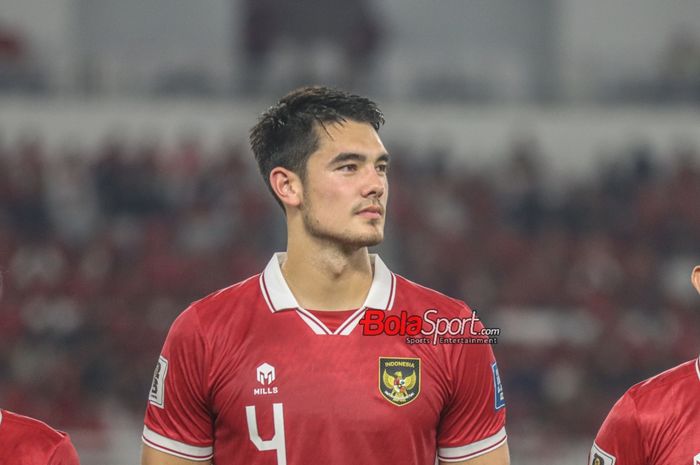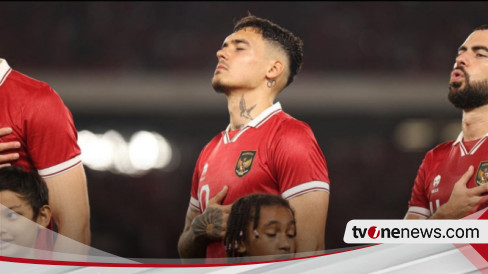
The Unseen Opponent: Navigating the Injury Crisis in the Indonesian National Football Team
Introduction
Indonesian football, a nation steeped in fervent passion for the beautiful game, has been on an upward trajectory in recent years. Under the astute guidance of South Korean tactician Shin Tae-yong, the Garuda squad has shown remarkable progress, challenging regional powerhouses and even making a mark on the continental stage. From reaching the knockout stages of the AFC Asian Cup for the first time in history to advancing deep into the FIFA World Cup Qualifiers, the future seems brighter than ever for the Red and White. However, beneath the surface of this newfound optimism lies a persistent and often debilitating challenge: a relentless wave of injuries plaguing key players. This unseen opponent not only tests the depth of the squad but also forces tactical compromises, dampens morale, and threatens to derail the national team’s ambitious aspirations.
This article delves into the recent injury woes affecting the Indonesian national football team, examining the specific cases of crucial players, exploring the underlying causes contributing to this crisis, analyzing its multifaceted impact on the team’s performance and strategy, and discussing potential mitigation strategies for a more resilient future.
The Current Landscape of Injury Woes
The Indonesian national team, especially in recent competitive windows such as the FIFA World Cup Qualifiers and the AFC U23 Asian Cup, has been a revolving door of injured players. Rarely does Shin Tae-yong have the luxury of selecting a fully fit squad. From star attacking midfielders to rock-solid defenders and indispensable wing-backs, no position seems immune to the clutches of muscle strains, ligament tears, and chronic fatigue. This constant battle against physical attrition forces coaching staff to make difficult decisions, often deploying players out of position or relying on less experienced alternatives, thereby compromising the team’s optimal performance.
The frequency and timing of these injuries are particularly concerning, often striking just before crucial fixtures. This pattern suggests a systemic issue, rather than isolated incidents, pointing towards a complex interplay of factors ranging from intense playing schedules to player workload management and the quality of domestic league infrastructure.
Key Players Affected: A Deeper Look
To truly understand the gravity of the situation, it’s imperative to examine the impact of injuries on specific, indispensable players who form the backbone of Shin Tae-yong’s squad:
-
Marselino Ferdinan (Attacking Midfielder):
Perhaps the most significant and recurring injury concern revolves around Marselino Ferdinan, the prodigious attacking midfielder hailed as one of Indonesia’s brightest talents. Currently plying his trade with KMSK Deinze in Belgium, Marselino’s dynamic playmaking, incisive runs, and powerful shots make him the creative lynchpin of the Garuda attack. However, his burgeoning career has been repeatedly hampered by recurrent hamstring issues. These injuries, often flaring up during crucial training camps or competitive matches, force him to the sidelines for weeks, sometimes months. His absence deprives the team of its primary creative spark, forcing Shin Tae-yong to rethink midfield dynamics and often resulting in a less fluid offensive output. The persistent nature of his hamstring problems also raises questions about his physical conditioning, recovery protocols, and the demands placed on a young player adapting to high-level European football while also bearing the burden of national expectations. -
Pratama Arhan (Left Wing-Back):
Known for his tireless work rate, defensive solidity, and the iconic long-throw weapon, Pratama Arhan is a vital component of Indonesia’s left flank. His energy and ability to cover the entire wing are crucial for Shin Tae-yong’s high-pressing, high-intensity system. Arhan has frequently battled muscle fatigue and minor strains, particularly in his adductor and hamstring areas. While often not leading to prolonged absences, these recurring niggles limit his explosiveness and stamina, especially in the latter stages of demanding matches. The sheer volume of games he plays, both for his club (currently Suwon FC in South Korea) and the national team, coupled with his high-octane playing style, makes him susceptible to overuse injuries. His occasional unavailability means losing a unique tactical weapon and a reliable defensive presence on the left. -
Asnawi Mangkualam (Right Wing-Back/Captain):
The team captain and a natural leader on the pitch, Asnawi Mangkualam brings tenacity, aggression, and defensive acumen to the right-back position. His ability to shut down opposing wingers and contribute to the attack makes him irreplaceable. Asnawi is no stranger to various knocks, muscle strains, and ankle issues, often a direct consequence of his combative and all-action playing style. His determination to win every duel means he frequently puts his body on the line, increasing his susceptibility to impact injuries or strains from sudden movements. When Asnawi is out, the team not only loses a key defensive asset but also a significant portion of its on-field leadership and competitive spirit, forcing others to step up in his absence. -
Elkan Baggott (Centre-Back):
The towering centre-back, with his imposing physical presence and aerial prowess, is a critical figure in Indonesia’s defensive line. Playing for Ipswich Town in England, Elkan Baggott has faced his share of injury setbacks, including shoulder and ankle issues. His robust playing style, common in the physical English leagues, puts immense strain on his joints and muscles. While his club career has seen him manage these issues, his call-ups to the national team often coincide with periods where he is either recovering or not fully match-fit, leading to concerns about his readiness. His absence removes a significant aerial threat in both boxes and a much-needed physical presence against larger opponents, forcing a reshuffle in the central defensive pairing. -
Jordi Amat & Justin Hubner (Centre-Backs):
The naturalized defenders, Jordi Amat (currently with Johor Darul Ta’zim in Malaysia) and Justin Hubner (currently with Cerezo Osaka in Japan), bring immense experience, composure, and tactical intelligence to the Indonesian backline. Both have had their moments on the treatment table. Amat has contended with shoulder and knee problems, limiting his availability at times. Hubner, despite his youth, has faced the rigours of playing in top European leagues (recently Wolves U21) and then a demanding Asian league, leading to fatigue and minor knocks that can accumulate. Their presence is vital for the team’s defensive stability, and any injury to either of them creates a significant void, forcing Shin Tae-yong to rely on less experienced or less compatible pairings.
Other players, such as Witan Sulaeman, Egy Maulana Vikri, Ivar Jenner, and Nadeo Argawinata, have also faced periods of injury or illness, further compounding the squad selection challenges.
Root Causes and Contributing Factors
The pervasive nature of injuries in the Indonesian national team points to several interconnected root causes:
-
Domestic League Schedule Congestion (Liga 1):
Liga 1, Indonesia’s top-tier domestic league, is notorious for its packed schedule and often insufficient rest periods between matches. With a long season and frequent mid-week games, players are subjected to intense physical demands without adequate recovery time. This relentless grind contributes significantly to muscle fatigue, increasing the risk of strains and tears. -
International Calendar Overlap and Demands:
The international football calendar is increasingly congested. Indonesian players often transition directly from demanding club seasons to high-stakes national team duties, including FIFA World Cup Qualifiers, AFF Championship, and age-group tournaments like the AFC U23 Asian Cup. There is often no real "off-season" for recovery and pre-season conditioning, leading to an accumulation of fatigue and chronic injuries. -
Player Workload and Shin Tae-yong’s System:
Shin Tae-yong’s tactical philosophy emphasizes a high-intensity, high-pressing game that demands immense physical output from every player. While effective, this demanding style requires peak physical conditioning and meticulous load management. The training sessions themselves are rigorous, designed to build endurance and tactical understanding, but without proper recovery, they can also contribute to player breakdown. -
Pitch Conditions:
While improving, some football pitches in Indonesia, both for training and matches, may not always meet international standards. Uneven surfaces or hard pitches can increase the risk of ankle twists, knee injuries, and impact-related problems. -
Medical Infrastructure and Sports Science:
The quality of sports science, physiotherapy, and injury prevention protocols can vary significantly between clubs in Indonesia. While the national team setup has its own dedicated medical staff, the continuous monitoring and sophisticated recovery strategies seen in top European leagues might not be uniformly applied across all domestic clubs. A lack of comprehensive data on player load and recovery across their club and national team commitments can lead to overtraining or insufficient recovery. -
Mental Fatigue:
Beyond the physical toll, the constant pressure to perform, travel, and switch between club and national team environments can lead to mental fatigue. This can indirectly affect physical performance and increase susceptibility to injuries due to decreased concentration or slower reaction times.
Impact on the National Team
The injury crisis has a profound and multi-faceted impact on the Indonesian national team:
-
Squad Depth Challenges:
The most immediate impact is the severe test of squad depth. When key players are sidelined, Shin Tae-yong is often forced to field less experienced players or play individuals out of their natural positions, compromising the team’s balance and effectiveness. This also limits tactical flexibility, as specific game plans built around certain players cannot be executed. -
Tactical Adjustments and Compromises:
Shin Tae-yong’s intricate tactical plans often rely on specific player profiles. The absence of a key player like Marselino Ferdinan means the attacking patterns need to be re-calibrated, potentially leading to a less creative or less potent offense. Similarly, losing a defensive anchor like Elkan Baggott or Jordi Amat forces a less stable backline. These last-minute adjustments can disrupt team cohesion and understanding. -
Team Cohesion and Morale:
Constant changes to the starting XI due to injuries can hinder the development of strong on-field chemistry and understanding among players. Moreover, seeing teammates repeatedly sidelined can take a psychological toll on the entire squad, affecting morale and confidence, especially if the team struggles to perform in the absence of key figures. -
Performance in Crucial Matches:
Ultimately, the biggest impact is on the team’s performance in critical matches. Whether it’s a World Cup Qualifier or a knockout stage game in a continental tournament, the absence of crucial players can be the difference between victory and defeat, potentially jeopardizing the national team’s progress and aspirations. -
Shin Tae-yong’s Dilemma:
For Coach Shin Tae-yong, the injury crisis is a persistent headache. He constantly faces the dilemma of balancing player welfare with the need to achieve results. It forces him to be adaptable and innovative but also adds immense pressure and frustration when his best-laid plans are disrupted by unforeseen physical setbacks.
Mitigation Strategies and Future Outlook
Addressing the injury crisis requires a holistic and collaborative approach involving the PSSI (Football Association of Indonesia), Liga 1 clubs, and the national team coaching staff:
-
Optimized Domestic League Scheduling:
PSSI, in conjunction with Liga 1 operators, needs to prioritize player welfare by designing a more sensible domestic league calendar. This includes ensuring adequate rest periods between matches, incorporating mid-season breaks, and managing travel logistics to minimize player fatigue. -
Enhanced Club-National Team Collaboration:
There needs to be seamless communication and data sharing between club medical teams and the national team’s sports science department. Regular updates on player load, recovery status, and injury prevention protocols are crucial to avoid overtraining or rushing players back prematurely. -
Investment in Sports Science and Medical Infrastructure:
Both clubs and the national team should continue to invest heavily in state-of-the-art sports science facilities, qualified physiotherapists, nutritionists, and performance analysts. Utilizing data analytics for player load management, injury prediction, and personalized recovery plans can significantly reduce the risk of non-contact injuries. -
Player Education and Self-Care:
Players need to be educated on the importance of proper nutrition, hydration, sleep, and personal recovery techniques. Empowering players to take responsibility for their own bodies and understand the signs of fatigue can go a long way in preventing injuries. -
Depth Building and Youth Development:
While naturalized players bring immediate quality, a sustainable long-term solution involves consistently developing a larger pool of talent through robust youth development programs. This ensures that when injuries strike, there are capable and well-prepared domestic players ready to step into the breach without a significant drop in quality. -
Pitch Quality Improvement:
Continued efforts to improve the quality of pitches across Indonesia, both at training grounds and match venues, will contribute to player safety and reduce injury risks.
Conclusion
The injury crisis in the Indonesian national football team is a significant hurdle that threatens to impede the nation’s footballing progress. While the passion and talent are undeniable, the physical resilience of the squad remains a critical area for improvement. It is a complex issue rooted in demanding schedules, high-intensity play, and varying levels of sports science infrastructure.
Addressing this "unseen opponent" requires a concerted, long-term effort from all stakeholders: the PSSI, Liga 1 clubs, and the players themselves. By prioritizing player welfare through optimized scheduling, advanced sports science, and collaborative medical oversight, Indonesian football can build a more robust and resilient national team. Only then can the Garuda truly unleash its full potential, free from the shackles of the treatment room, and continue its inspiring journey towards becoming a dominant force in Asian football. The dream of competing consistently on the global stage hinges not just on tactical brilliance and individual talent, but equally on the physical fortitude of its warriors.



